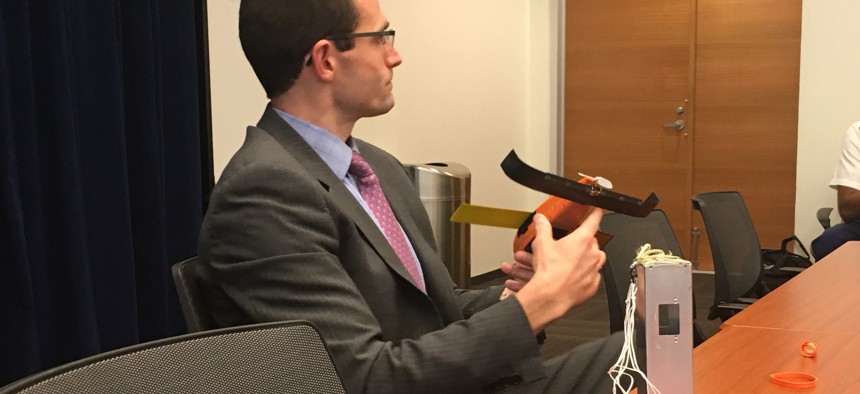
Will Roper, the director of the Strategic Capabilities Office, explains how the protective canister on the table protects the fourth-generation swarming Perdix drone in his hand as the micro-UAV deploys from a fighter jet's flare dispenser. Caroline Houck
These Swarming Drones Launch from a Fighter Jet’s Flare Dispensers
The Pentagon’s Strategic Capabilities Office is building — and rapidly improving — them with commercial parts and 3D-printed fuselages.
It’s no secret the U.S. military is looking to low-cost swarming drones for the next wave of unmanned technology: The Navy has its LOCUST program; the Air Force has Gremlins, and even the Army has tested out the concept. What differentiates the Strategic Capabilities Office’s unmanned aerial vehicle called Perdix isn’t just its soda-bottle size — far smaller than LOCUST’s meter-long Coyote UAVs — or its focus on surveillance, not attack. It’s also that SCO’s micro-UAV is assembled entirely from commercial parts fitted into a 3D-printed fuselage.
Working with the Air Force, SCO designed Perdix to launch out of a fighter jet’s flare dispenser—one of the few places the streamlined aircraft can fit expendable items. The dispenser’s size and lack of temperature regulation helped winnow down a broad idea—expendable swarming micro-UAVs—to a specific, viable project, SCO Director Will Roper said.
“We designed Perdix to move quickly and to deal with weather, also to deal with temperature, and that’s really not something a hobbyist is paying for in a UAV,” Roper told reporters Thursday. “They probably don’t need something that works at minus-40. So we can’t go buy a UAV off a shelf, shove it in a flare dispenser, and hit the button and have it work. But what’s great and amazing is that every single piece of Perdix has a part number. You could go order it and build one.”
The assembled commercial components are finished off with a 3D-printed outer mold line from MIT Lincoln Laboratory. Those sourcing decisions give the project an edge, Roper said. Rather than spending money to obtain an “end-zone” technology now that may be outdated in a year or two, the Air Force can incorporate continual innovations from the commercial sector.
“Could the DOD go build an improvement on each of those components?” Roper said. “Absolutely. But it’s smart to stay inside the commercial base, because it’s going to improve itself. A lot of the pieces come from microelectronics that have been driven by the smartphone industry, and that continues to improve.”
The model fits within SCO’s overall ethos and also means that they’ve been able to rapidly upgrade prototypes after every operational test at minimal cost, Roper said. They’ve flown the UAV more than 500 times—about 300 of them from aircraft—and are now on Perdix’s seventh generation.
At an operational exercise called Northern Edge in Alaska, “we had F-16s and F-18s carry and deploy swarms of Perdixes that flew,” Roper said. “Then we took the feedback from that—that was three design spirals ago—and we have updated the design for improved performance. And not just that, but [we could] take the feedback from the run at the mission and then do changes to the design to the software and then re-fly it the next day.”
In tests, the Air Force and SCO will look to burn down some of the program’s risk, establishing loiter time, reliability ratings, speed, and other specifics. Roper said they’ll decide at the end of the next fiscal year if the program is ready to move to the Air Force.
“We have to get a lot of airdrops of these aircraft to be able to tell the Air Force they have a reliability rating of pick-a-number,” he said. “If the rating isn’t high and the Air Force needs these for a critical mission, they have to go find a target quickly, it’s not a good match.”
That surveillance mission would be carried out by a swarm deployed from a fast-moving fighter, with each dormant Perdix shielded from the winds of traveling at several hundred meter per second winds by a carbon fiber canister that eventually separates from the drone.
“Once it wakes up, stabilizing in flight, it’s trying do the cross-links to all its brothers and sisters, and then it knows its mission,” Roper said. “And when I say ‘it,’ I’m really talking about the swarm. As a unit, they know what they’re supposed to do. So say we’re telling these guys to go out and survey a field. As a group they have that mission, and what they’ll do is allocate and optimize the best way to do it. All the user has to talk to is the swarm.”
Here’s a video of a Perdix deployment, first obtained by the Washington Post.
NEXT STORY: The US Has Its First Cybersecurity Director





